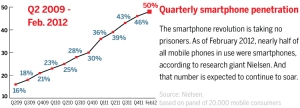This is the final blog post about my learning path within the digital world. This post will concentrate on my personal experience through this journey, as well as reflecting on how the digital world has moved yet further ahead.
When starting my journey back in September, I was quite oblivious of the fact that there is another world, a digital world where companies enhance their brand images by utilising social media and other channels to engage with the public. Interaction and content that are used by more companies allowing them to create an environment where consumers “share their experiences” about products and services with one another, “express their approval or disapproval” and also “give their recommendations” regarding products and services (Laudon and Traver, 2012). I can see the digital world moving the way companies like Barclays do business as they introduced their “Barclaycard Ring” which allows customer interaction with the company combining social media and on-line banking. The DCS unit gave me a vast amount of knowledge of the digital world, however I have found that this world has very little attraction for me.
I was also unaware of the fact that 50% of consumers in the UK who own a smartphone and 42% of consumers who use social networks as a communication tool (Key Note, 2013), and all those people I see on a bus or in a café who are addicted to their mobile phones, are using digital mediums such as Facebook and Twitter to socialise with their friends, and are therefore exposed to constant advertising by marketers. Mobile marketing has created an opportunity for companies to filter the right types of advertising to serve and target the consumers on social networks.
An important element of this activity is consumer “location” as it determines the relevance and context of messages sent. This is supported by Chahal (2013a) who states that “location” has become important to consumers as nearly 50% of searchers are expecting search locations to be within driving or walking distance. I believe advertising on smartphones will be utilised more and more by companies in the future and targeted ads with the relevant content will lead to a higher purchase rate from consumers which will bring potential returns to mobile marketing and also assist in more understanding of the benefits of mobile optimisation (Mobile Marketing Watch, 2013a).
Yet another aspect of the change we are all witnessing is the change in the High Street and the on-going adaptation of Fashion within the digital world. The High Street is undergoing a drastic restructuring, as some of the retailers fail to adapt to the digital innovations to meet the needs of the consumers who are starting to embrace social window shopping. The “Global Market Insite” supports this by stating that 27% of consumers turn to social media to get ideas for future purchases (Sarma, 2013). This is a somewhat different shopping experience unlike, in former days, when consumers would purchase something once they have tried it on. Today, however, consumers want multi-channel brand experience, this means that in the future we might see more of “show-rooming”, meaning consumer browsing in-store but buying online (Chahal, 2013b).
Fashion has also been affected by digital change as social media has played its role in making fashion more accessible and instantaneous for consumers. Perry (2013) states that nowadays “fashionistas” get access to images and what is happening during fashion week within minutes, as this can be seen across all social platforms from Twitter to Tumblr. Blogs have also moved fashion as it allows the creation of fashionable outfits on any budget from anywhere in the world.
I have found that the digital world revolves around consumers in the social media as businesses use the social media channels to advertise and reach the right target audience, in order to generate revenue. Businesses have been embracing blogs, YouTube, Facebook, Twitter, LinkedIn and other online media channels. Facebook’s Graph Search is a potential for revenue generation as it allows businesses the incorporation of commercial searches (Ghosh, 2013), Twitter’s keyword targeting in timelines allows businesses to make advertising targeting more accurate for consumers, the YouTube channel is utilised by some companies using “YouTube Partner Programme” and Affiliate marketing to promote their business, whereas LinkedIn allows businesses to generate the highest visitor-to-lead conversion rate (Cohen, 2013).
All the above is intended to be of help in generating revenue for businesses, however, after attending a TFM&A seminar in London, I have realised that the companies struggle to measure the “Return on Investment” (ROI) and therefore, this leads to questioning whether or not social media is actually helping the companies to generate revenue from utilising the different channels. Varini and Sarsi (2012) also highlight this and agree on this point by stating that companies do have difficulties measuring the ROI.
In conclusion, I feel that my journey through the digital world has been both a journey of discovery and an educational experience, however I find myself undertaking a role more of an observer rather than active participator in this digital change. I accept the fact that in the work place, especially in marketing, this is a strong and evolving force and is implemented by most businesses, however, I can state that social media has little impact on myself as a person and I will only use it within the professional environment.
Bibliography:
Chahal, M., 2013a. Brands should be using local relevancy in mobile ads. Marketing Week, 10 April 2013. Available from: http://www.marketingweek.co.uk/opinion/brands-should-be-using-local-relevancy-in-mobile-ads/4006257.article [Accessed 29 April 2013].
Chahal, M., 2013b. Open all hours: the future of the high streets. Marketing Week, 13 February 2013. Available from: http://www.marketingweek.co.uk/trends/open-all-hours-the-future-of-the-high-street/4005606.article [Accessed 30 April 2013].
Cohen, H., 2013. LinkedIn: Where the Money is (and 11 facts to prove it). Heidi Cohen. Available from: http://heidicohen.com/linkedin-where-the-money-is-and-11-facts-to-prove-it/ [Accessed 30 April 2013].
Ghosh, S., 2013. Facebook search to generate revenue, no rival to Google. USA: Thomson Reuters. Available from: http://www.reuters.com/article/2013/01/16/net-us-facebook-research-idUSBRE90F0QT20130116 [Accessed 30 April 2013].
Key Note, 2013. Digital Communications Market Report 2013. Teddington: Key Note. Available from: https://www.keynote.co.uk/ [Accessed 18 April 2013].
Laudon, K.C and Traver, C.G., 2012. E-commerce: business, technology, society. 8th ed. Harlow: Pearson Education.
Perry, C., 2013. How social media changed the face of fashion. Durham: Palatinate. Available from: http://www.palatinate.org.uk/?p=34825 [Accessed 30 April 2013].
Sarma, S., 2013. S-commerce: “social shopping” means browsing but not buying. Retail Digital. Available from: http://www.retail-digital.com/online_retailing/s-commerce-social-shopping-means-browsing-but-not-buying [Accessed 30 April 2013].
Varini, K. and Sirsi, P., 2012. Social Media and Revenue Management: Where should the two meet? Journal of Technology for Growing Economies, 3 (1), 33-46. Available from: http://ehis.ebscohost.com/eds/search/advanced?sid=2f860ab5-df57-49eb-88b5-e958cde5c128%40sessionmgr13&vid=2&hid=4 [Accessed 30 April 2013].
YouTube, 2013a. Barclaycard Ring How It Works. Available from: http://www.youtube.com/watch?feature=player_embedded&v=2ZYCT0aoPM0#! [Accessed 29 April 2013].
YouTube, 2013b. Mobile Video Marketing for Business | Mobile Marketing Statistics 2013. Available from: http://www.youtube.com/watch?v=r3rj9Dzu318 [Accessed 29 April 2013].


